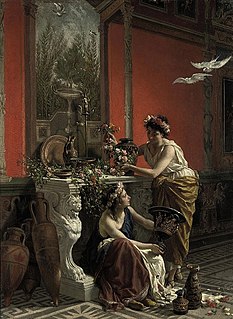Antonio Marinetti, also called il Chiozzotro (Chioggia, born circa 1700) was an Italian painter, active in a late-Baroque style.

Antonio Marinetti, also called il Chiozzotro (Chioggia, born circa 1700) was an Italian painter, active in a late-Baroque style.

He was a pupil of Giovanni Battista Piazzetta. [1] He painted the main altarpiece for the Church of Sant'Agostino in Treviso, depicting a Virgin and Child with St Augustine and the Blessed Girolamo Miani . Miani was one of the founders of the Order of Somaschi priests. He also painted for the same church, a Guardian Angel and Glory of St Joseph with Saint Anne and the Holy Family. For the church of San Lorenzo in Treviso, he painted a St Anthony Abbot. [2]

Lorenzo Lotto was an Italian painter, draughtsman, and illustrator, traditionally placed in the Venetian school, though much of his career was spent in other north Italian cities. He painted mainly altarpieces, religious subjects and portraits. He was active during the High Renaissance and the first half of the Mannerist period, but his work maintained a generally similar High Renaissance style throughout his career, although his nervous and eccentric posings and distortions represented a transitional stage to the Florentine and Roman Mannerists.

Gerolamo Emiliani was an Italian humanitarian, founder of the Somaschi Fathers, and is considered a saint by the Catholic church. He was canonized in 1767 and is the patron saint of orphans.

Treviso is a city and comune in the Veneto region of northern Italy. It is the capital of the province of Treviso and the municipality has 84,669 inhabitants. Some 3,000 live within the Venetian walls or in the historical and monumental center; some 80,000 live in the urban center while the city hinterland has a population of approximately 170,000..

Alvise or Luigi Vivarini (1442/1453–1503/1505) was an Italian painter, the leading Venetian artist before Giovanni Bellini. Like Bellini, he was part of a dynasty of painters. His father was Antonio Vivarini and his uncle, with whom he may have trained, was Bartolomeo Vivarini. Another uncle, on his mother's side, was the artist known as Giovanni d'Alemagna, who worked with his brother-in-law Antonio. Alvise may have trained Jacopo de' Barbari.

Paris Bordone was an Italian painter of the Venetian Renaissance who, despite training with Titian, maintained a strand of Mannerist complexity and provincial vigor.
Hieronimo Miani, also known as Hieronymus Miani, was an Italian history painter, who worked in Denmark as both a painter to the royal court of King Christian VI, and as a teacher.

Pietro (Libertino) Liberi was an Italian painter of the Baroque era, active mainly in Venice and the Veneto.

Antonio Zanchi was an Italian painter of the Baroque, active mainly in Venice, but his prolific works can also be seen in Padova, Treviso, Rovigo, Verona, Vicenza, Loreto, Brescia, Milano, and Bergamo, as well as Bavaria.

Tomaso Barisini, better known as Tommaso da Modena and sometimes called Tomaso Baffini was an Italian painter of the mid-14th century.

Cesare Mariani was an Italian painter and architect of the late-19th century, active in Rome and Ascoli Piceno.

Sante Peranda (1566–1638) was an Italian painter of the late-Renaissance period.

Andrea Vicentino was an Italian painter of the late-Renaissance or Mannerist period. He was a pupil of the painter Giovanni Battista Maganza. Born in Vicenza, he was also known as Andrea Michieli or Michelli. He moved to Venice in the mid-1570s and registered in the Fraglia or guild of Venetian painters in 1583. He worked alongside Tintoretto at the Palazzo Ducale in Venice, helping paint The Arrival of Henry III at Venice at the Sala delle Quattro Porte as well as works in the Sala del Senato and the Sala dello Scrutinio. He also painted the altarpiece Madonna of the Rosary for the Treviso Cathedral, God the Father with Three Theological Virtues (1598) for the church in Gambara, and St Charles Borromeo for a church in Mestre. Paintings by him exist in a number of galleries including the Raising of Lazarus at the National Museum of Fine Arts, Malta.

Bourgougnague is a commune in the Lot-et-Garonne department in southwestern France.

Lodewijk Toeput, called il Pozzoserrato was a Flemish landscape painter and draftsman active in Italy. He is mainly known for his canvases and frescoes of landscapes and formal gardens with banquets and music-making groups. His landscapes had an important influence on the next generation of Flemish landscape artists such as Joos de Momper, Tobias Verhaecht and Gillis and Frederik van Valckenborch.

Jacopo Guarana was a Venetian painter of the late Baroque period who was born in Verona. He was active mainly in Venice and its mainland territories.
Andrea Vinai was an Italian painter.
Giovanni Battista Canal or Canale was an Italian painter of the late Baroque and early Neoclassical era, active mainly depicting history and sacred subjects in his native Venice.
Giovanni Bonagrazia was an Italian painter, active in Treviso in a Mannerist style.
Domenico Mancini is an Italian painter of the Venetian mainland, painting in a High Renaissance style. Mancini was either a pupil or a close follower of Giorgione and Giovanni Bellini. He was born in Treviso, and is said to have worked alongside Pietro Maria Pennacchi.
Giovanni Carboncino was an Italian painter of the Baroque period, active between 1680 and 1692 mainly in Venice. He was born in Treviso, and became a pupil of Matteo Ponzone.